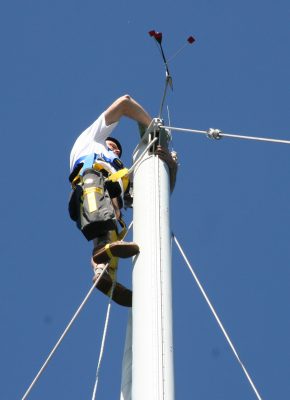Alex Blackwell explains how to use mast-climbing gear to go aloft
As much as I love sailing, there is one thing (besides rebuilding the head) that I really have a problem with, and that is the height of the mast. No, this has nothing to do with our mast being unable to clear certain bridges, but rather how incredibly high above the water you are when at its pinnacle. I admit that I have a real problem with heights. Then who doesn’t when swinging back and forth at the very end of a 60ft metronome?

Several times a season it is certainly a really good idea to climb up and visually inspect all the sheaves, turnbuckles, shackles, and other sundry fittings. The tip of the mast happens to be the business end of much of what makes sailing so pleasurable. So, I suppose it simply goes with the territory that its ascension is one of those things that you just need to come to grips with. After all, pretty much the last thing you want to happen is for your mast to come down. If you are a split rig aficionado, as we are, then be prepared for double the ‘fun’.

Aleria from above. Once you’ve inspected the mast you can enjoy the view!
Previously we used a regular bosun’s chair. One of us would muscle the other one up the stick with a winch. No choice task for my wife Daria, who is about half my size. We reviewed all the available options, which included steps and climbing gear, and settled on the Top-Climber, which lets me climb up a halyard at my own pace using my legs to lift me up. Like all gear you must inspect this equipment thoroughly each time prior to use.
The fear and adrenaline make this a slow climb at the best of times. I do not do very well on a step ladder, let alone suspended in mid space with just a skinny piece of rope holding me. Adding a second halyard attached to a separate harness did not take a stroke of genius and is something that we obviously would highly recommend. As this is not affixed at either end like the one I climb up with the Top-Climber, Daria tails this as I ascend and then belays it while I am at the top.
With the tip of the mast swinging pretty violently with even the slightest disturbance of the water, I also opted to use my ski helmet (or bicycle helmet) to protect my head. This is something we spotted Dame Ellen MacArthur doing in a photograph taken far offshore somewhere and it was one of those “Duh!” revelations we frequently have. I had just come back down having worked on our anemometer and was complaining about the bruises on my shoulders and noggin. Yeah it sometime takes a little knock on the head to loosen the cobwebs enough to come up with a sensible thought.

As we have often pointed out we tend to learn a lot from our own mistakes – and we certainly make our fair share of them. I once lost my favourite wrench to the depths of the sea from the top of the mast. It was actually quite lucky that the mast was at the maximum amplitude of its swing when I dropped it.
The wrench flew past the side of the boat landing in the water with a nice splash. Had it not done so and landed on the deck or coachroof, it would surely have caused some significant damage or worse yet had it hit Daria. Anything of value I bring up with me is now tied with its own lanyard.
This takes a bit of planning and preparation, as I try to make sure I don’t have a tangled mess when I get up there. I also always bring at least two screwdrivers along. Should I lose one, I won’t have to go down and up again to finish my work. I also make sure there is nobody underneath me while I am working aloft. (Yes, something did drop, and no, it did not hit Daria, but yes it came close, and yes, it did ‘dent’ the coachroof.)
No, going aloft is a task I will never cherish. The view, however, is always magnificent. We have many excellent photos of harbours and anchorages from this perspective. From up there you also get the opportunity of reviewing your deck layout. If you love your boat as much as we do, a new viewing angle can actually be quite the treat.
About the author
Alex and Daria Blackwell are the authors of Happy Hooking – The Art of Anchoring. Now in its third edition, it covers every aspect of anchors and anchoring and is available from chandleries, CoastalBoating.net and Amazon.




